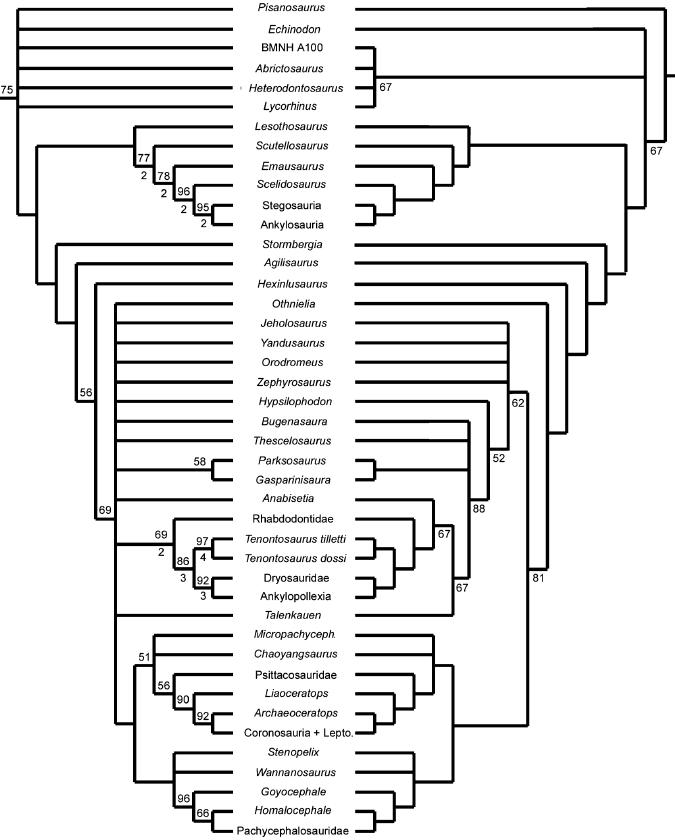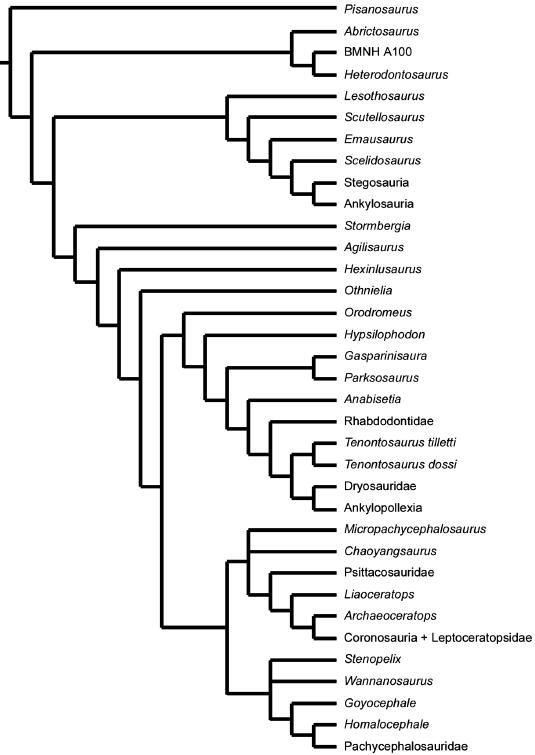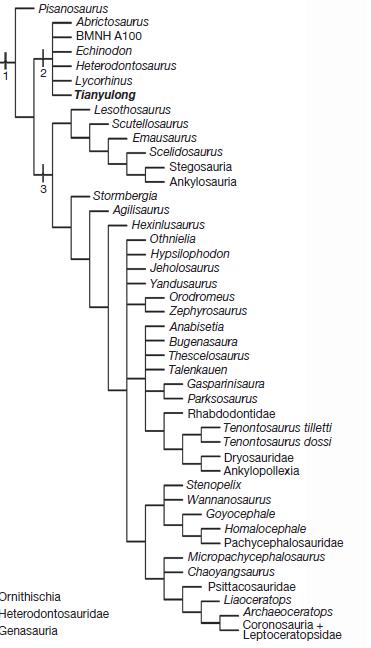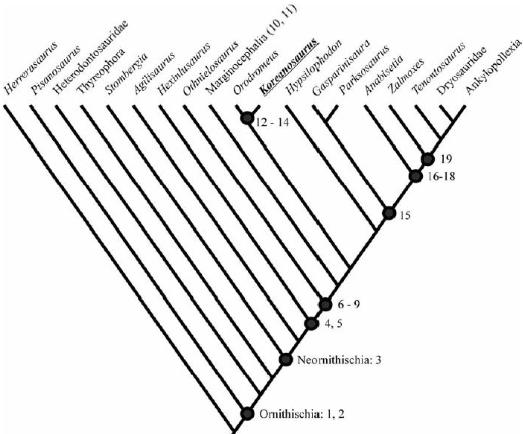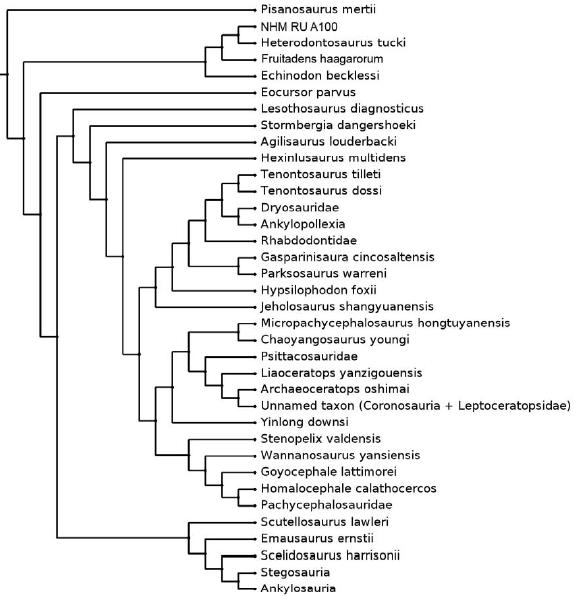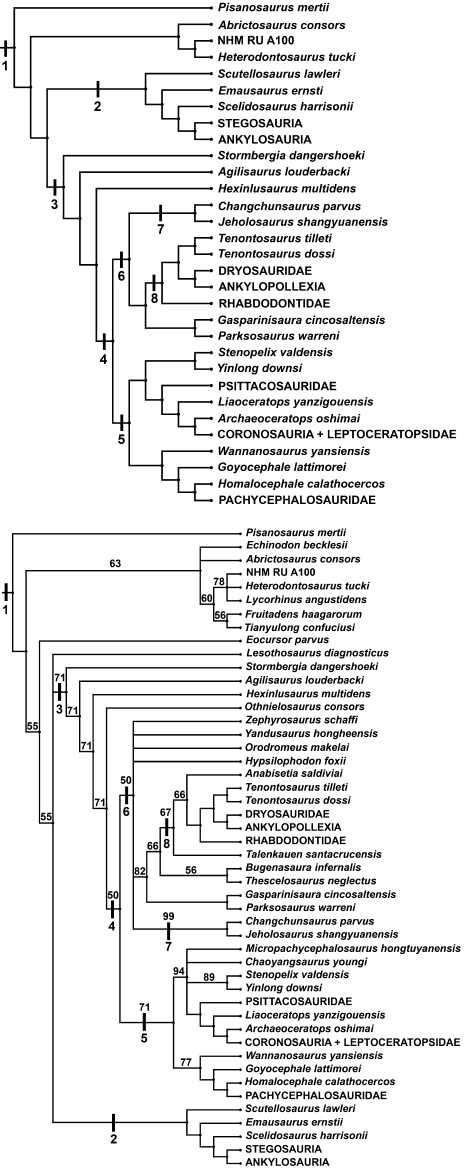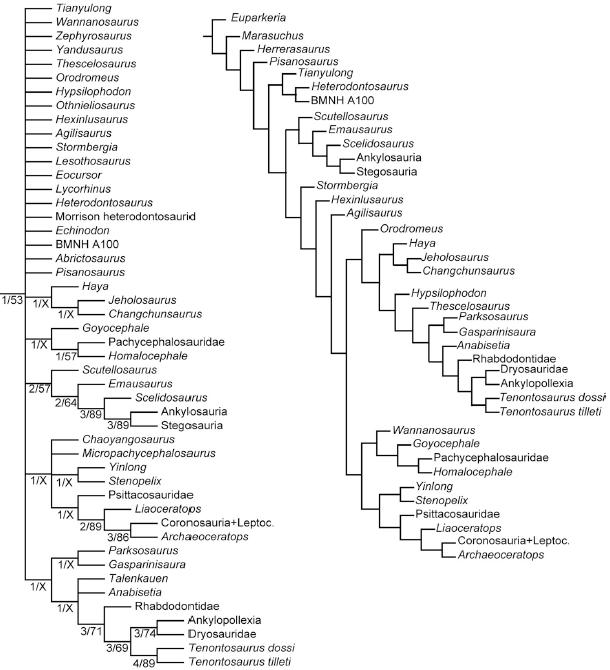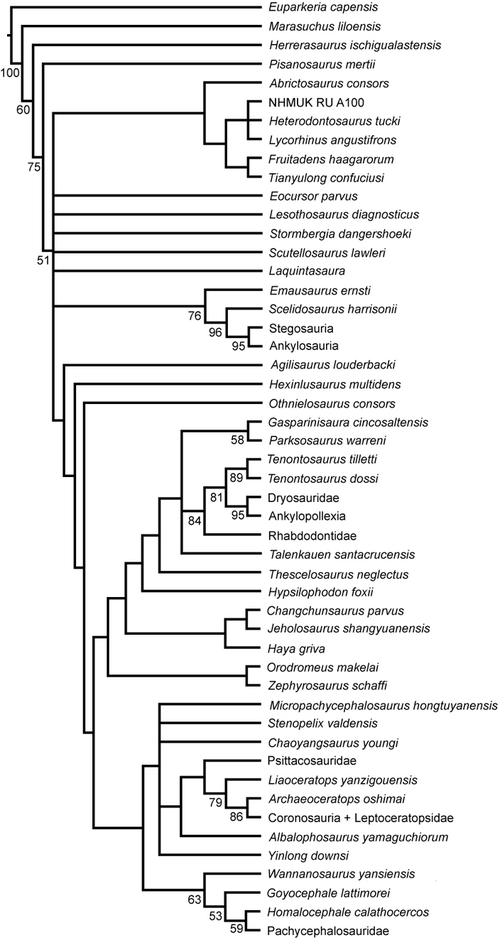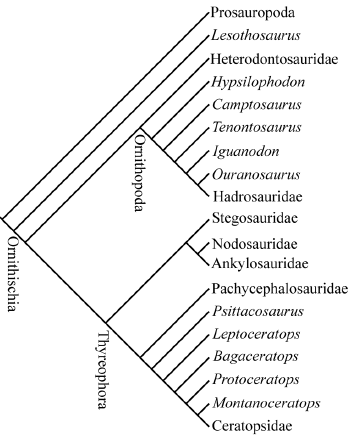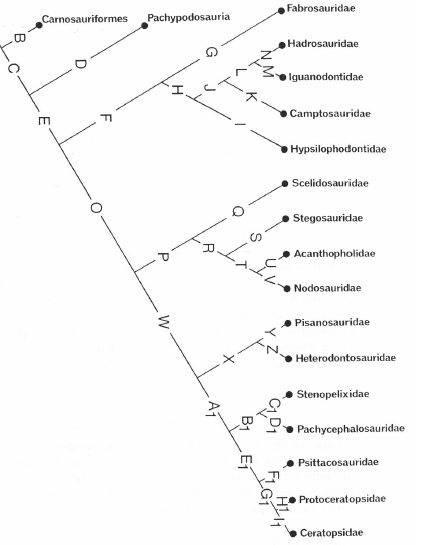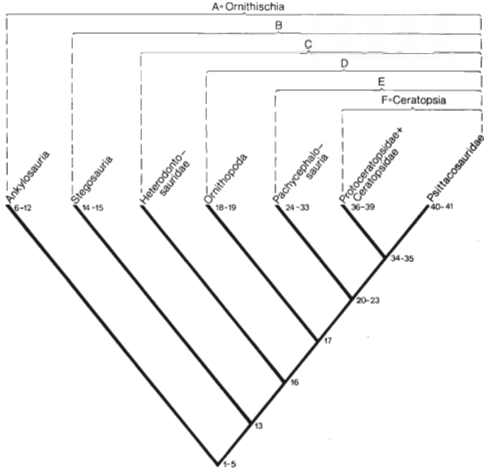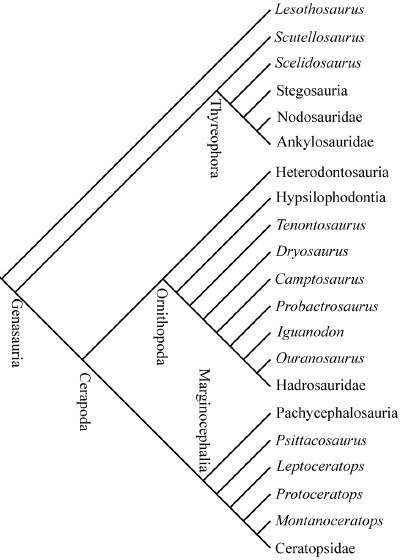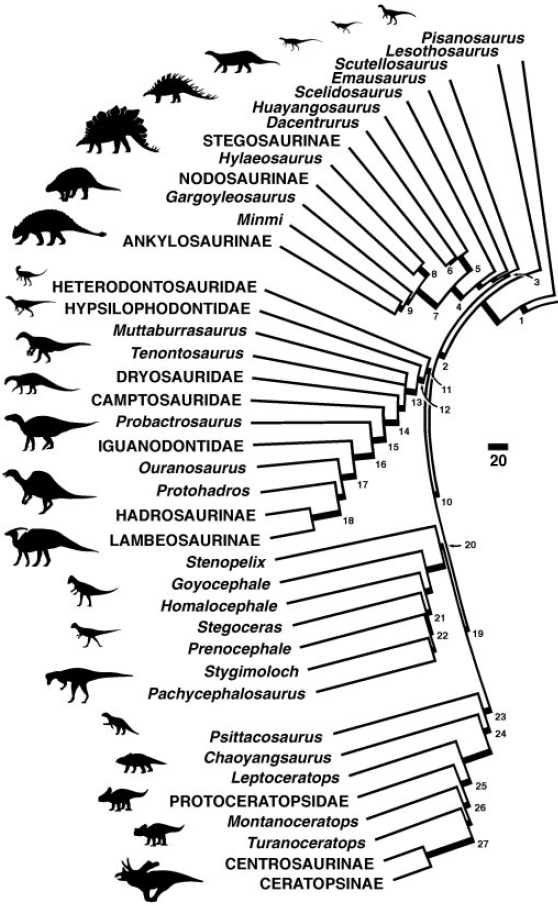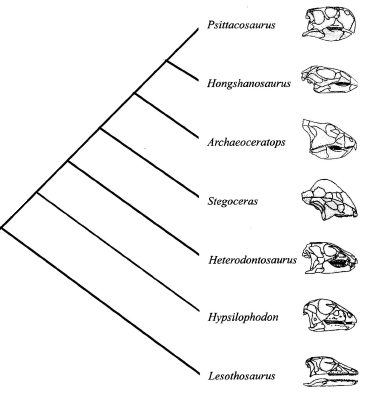Kategoria:Ornithischia
| Autor: |
| Maciej Ziegler |
| Ornithischia (ptasiomiedniczne) | |
|---|---|
| Czas występowania |
201 - 66 Ma |
| Dieta | roślinożerne |
| Rozmiary | do 15 m długości |
| Występowanie | cały świat |
| Systematyka | Dinosauria
|
Kategoria przedstawia nomenklaturę i filogenezę Ornithischia - głównie bazalnych tj. nie należących do Eurypoda (Ankylosauria+Stegosauria) ani Cerapoda (Ornithopoda+Ceratopsia+Pachycephalosauria), ale częściowo także bazalnych Ornithopoda (czasem nawet bazalnych Iguanodontia), bazalnych Thyreophora, Pachycephalosauria i bazalnych Ceratopsia.
Jest to zalążek przyszłego artykułu (jeśli możesz - napisz go!).
Ornithischia (dinozaury ptasiomiedniczne) - jedna z dwóch (obok Saurischia) grup wyróżnianych wśród Dinosauria. Pojawiły się w triasie, wymarły na końcu kredy - ok. 65,5 Ma (lub nieznacznie później).
Nomenklatura
- Ornithischia (Seeley, 1887)
- Triceratops horridus ~ Passer domesticus (zmodyfikowano z Padian i May 1993)
- Heterodontosauriformes (Xu, Forster, Clark i Mo, 2006)
- <Heterodontosaurus tucki & Triceratops horridus (zmodyfikowano z Xu, Forster, Clark i Mo, 2006)
- Klad ten nazwano przyjmując hipotezę, że Heterodontosauridae są taksonem siostrzanym Marginocephalia. Jednak pozycja Heterodontosauridae jest niepewna. Jeśli Heterodontosauridae są bazalnymi Ornithischia (np. Butler i in., 2008) to zasięg kladu obejmuje niemal wszystkie Ornithischia (co może być niezgodne z pierwotnie zakładanym zasięgiem nazwy) a jeśli należą do Ornithopoda (np. Sereno, 1999), to jest młodszym synonimem Cerapoda.
- Heterodontosauridae (Kuhn, 1966 albo Romer, 1966)
- >Heterodontosaurus tucki ~ Parasaurolophus walkeri (zmodyfikowano z Sereno, 1998)
- Heterodontosaurinae (Kuhn, 1966 albo Romer, 1966 sensu Sereno, 2012)
- >Heterodontosaurus tucki ~ Tianyulong confuciusi v Fruitadens haagarorum v Echinodon becklesii (Sereno, 2012)
- Genasauria (Sereno, 1986)
- <Triceratops horridus & Ankylosaurus magniventris (zmodyfikowano z Sereno, 1998)
- Neornithischia (Cooper, 1985)
- >Triceratops horridus ~ Ankylosaurus magniventris (zmodyfikowano z Sereno, 1998)
- Cerapoda (Sereno, 1986)
- <Parasaurolophus walkeri & Triceratops horridus (Buchholz, 2002 [? Barrett, Butler i Knoll, 2005])
- Często jest traktowane jako młodszy synonim Neornithischia. Pierwszą opublikowaną definicją jest prawdopodobnie powyższa - zaproponowana przez Buchholza w 2002 r. albo, co na gruncie tego, co napisali Butler i in. (2008: tabela 1 oraz s. 6) wydaje się mało prawdopodobne, ta zawarta w pracy Normana i in. z 2004 r. - będąca odpowiednikiem Neornithischia: (Triceratops ~ Ankylosaurus).
- Ornithopoda (Marsh, 1881)
- >Edmontosaurus regalis ~ Triceratops horridus (Norman, Sues, Witmer i Coria 2004)
- Pierwsza definicja Sereno, 1998 (<Heterodontosaurus & Parasaurolophus) przy wielu hipotezach filogenezy powoduje, że należą do niego niemal wszystkie Ornithischia, co może kłócić się z pierwotnym zamierzeniem i obecnym stosowaniem nazwy. W przyjętym tu znaczniu starszy synonim Euornithopoda.
- Marginocephalia (Sereno, 1986)
- <Pachycephalosaurus wyomingensis & Triceratops horridus (zmodyfikowano z Sereno, 1998)
- Pachycephalosauria (Maryańska i Osmólska, 1974)
- >Pachycephalosaurus wyomingensis ~ Triceratops horridus (Maryańska, Chapman, i Weishampel; zmodyfikowano z Sereno, 1998)
- Ceratopsia (Marsh, 1890)
- >Triceratops horridus ~ Pachycephalosaurus wyomingensis (zmodyfikowano z Sereno, 1998)
- Thyreophora (Nopcsa, 1915)
- >Ankylosaurus magniventris ~ Triceratops horridus (zmodyfikowano z Sereno, 1998)
- Eurypoda (Sereno, 1986)
- <Stegosaurus armatus & Ankylosaurus magniventris (zmodyfikowano z Sereno, 1998)
- Stegosauria (Marsh, 1877)
- >Stegosaurus armatus ~ Ankylosaurus magniventris (zmodyfikowano z Galton, 1997)
- Ankylosauria (Osborn, 1923)
- >Ankylosaurus magniventris ~ Stegosaurus armatus (zmodyfikowano z Carpenter, 1997)
Kladogramy
Analizy Butlera (2005; i in., 2008) i modyfikacje
W badanach filogenezy bazalnych Ornithischia prym wiodą obecnie obszerne analizy oparte na matrycy Butlera (2005), rozwiniętej przez Butlera, Upchurcha i Normana (2008).
Butler 2005
Kladogram z Butler, 2005
Butler i in. 2007
Kladogram z Butler i in., 2007 (na podstawie Butler, 2005 ze zmianami)
Butler i in. 2008
Kladogram z Butler i in., 2008 (na podstawie Butler, 2005 z wieloma zmianami): ugóry: na lewo ścisły konsensus, na prawo 50% majority-rule consensus. Na dole: kladogram po usunięciu Echinodon, Lycorhinus, Bugenasaura, Jeholosaurus, Talekauen, Thescelosaurus, Yandusaurus i Zephyrosaurus
Ohashi i Barrett 2009
Kladogram z Ohashi i Barrett 2009 (na podstawie Butler i in., 2008 z dodanym Albalophosaurus)
Zheng i in. 2009
Kladogram z Zheng i in., 2009 (na podstawie Butler i in., 2008 z dodanym Tianyulong i rewizją kilku cech).
Huh i in. 2011
Kladogram z Huh i in., 2011 (na podstawie Butler i in., 2008 z dodanym Koreanosaurus), uproszczony
Butler i in. 2010
Kladogram z Butler i in., 2010 (na podstawie Butler i in., 2008 z dodaniem Fruitadens, Eocursor , Tianyulong i Yinlong, z odjęciem Abrictosaurus, dodaniem 6 cech i drobnymi zmianami)
Pol i in. 2011
Kladogram z Pol i in., 2011 (na podstawie Butler i in., 2010 z dodanym Manidens, 3 nowymi cechami i innymi zmianami)
Butler i in. 2011
Kladogram z Butler i in., 2011 (na podstawie Butler i in., 2008 z dodaniem Fruitadens, Eocursor , Tianyulong i Yinlong, z odjęciem Abrictosaurus, dodaniem 6 cech i wieloma innymi zmianami). Na górze kladogram z usuniętymi problematycznmi taksonami, na dole 50 majority rule.
Makovicky i in. 2011
Kladogram z Makovicky i in., 2011 (na podstawie Butler i in., 2011 z dodanym Haya i drobnymi zmianami). Na lewo ścisły konsensus, na prawo konsensus po odjęciu 12 taksonów.
Ruiz-Omenaca i in. 2012
Kladogram z Ruiz-Omenaca i in., 2012 (na podstawie Makovicky i in., 2011 z dodanym Gideonmantellia, zmianą 1 cechy i usunięciem Othnielosaurus, Yandusaurus i Zephyrosaurus).
Han i in. 2012
Kladogram z Han i in., 2012 (na podstawie Butler i in., 2011 z dodanymi Albalophosaurus, Yueosaurus, Koreanosaurus, Haya i usunięciem Bugenasaura) - ścisły konsnensus po usunięciu Yandusaurus hongheensis, Anabisetia, Echinodon, Yueosaurus i Koreanosaurus.
Do Jeholosauridae mogą należeć Koreanosaurus i Yueosaurus (drzewa majority rule z usuniętymi ww.).
Barrett i in. 2014
Kladogram z Barrett i in., 2014 (na podstawie Han i in., 2012 z dodaną Laquintasaura i usunięciem Yandusaurus hongheensis, Anabisetia, Echinodon, Yueosaurus i Koreanosaurus).
Godefroit i in. 2014
Kladogram z Godefroit i in., 2014 (na podstawie Han i in., 2012 z dodanym Kulindadromeus i usunięciem Yandusaurus hongheensis, Anabisetia, Echinodon, Yueosaurus, Koreanosaurus i Othnielosaurus).
Inne
Norman 1984
Kladogram z Norman, 1984. H1, H2 - alternatywne położenia dla Heterodontosauridae; P1, P2 - alternatywne położenia dla Pachycephalosauria.
Sereno 1984
Kladogram z Sereno, 1984
Cooper 1985
Cooper, 1985 (brak analizy numerycznej)
Maryańska i Osmólska 1985
Maryańska i Osmólska, 1985 (brak analizy numerycznej)
Sereno 1986
Kladogram z Sereno, 1986 (uproszczone)
Sereno 1999
Kladogram z Sereno, 1999 (kompozycja kilku analiz)
Buchholz 2002
Kladogram z Buchholz, 2002 - 50% majority-rule consensus
You i in. 2003
Kladogram z You i in., 2003
Xu i in. 2006
Kladogram z Xu i in., 2006 (cechy za Xu i in., 2002)
Sereno 2012
Skalibrowany stratygraficznie kladogram z Sereno, 2012; ukazujący też główne specjalizacje związne z odżywianiem się.
Bibliografia
Barrett, P.M., Butler, R.J., Mundil, R., Scheyer, T.M., Irmis, R.B. & and Sánchez-Villagra, M.R. (2014) "A palaeoequatorial ornithischian and new constraints on early dinosaur diversification" Proceedings of the Royal Society B: Biological Sciences, 281(1791), 20141147. doi: 10.1098/rspb.2014.1147
Buchholz, P.W. (2002) "Phylogeny and biogeography of basal Ornithischia" [w"] The Mesozoic in Wyoming, Tate 2002. Casper, Wyoming: The Geological Museum, Casper College, 18–34. [kladogram zamieszczony w Boyd i in., 2009]
Butler, R.J. (2005) "The 'fabrosaurid' ornithischian dinosaurs of the Upper Elliot Formation (Lower Jurassic) of South Africa and Lesotho" Zoological Journal of the Linnean Society, 145(2), 175-218.
Butler, R.J., Smith, R.M.H. & Norman, D.B. (2007) "A primitive ornithischian dinosaur from the Late Triassic of South Africa, and the early evolution and diversification of Ornithischia" Proceedings of the Royal Society B: Biological Sciences, 274(1621), 2041-2046. doi:10.1098/rspb.2007.0367
Butler, R.J., Upchurch, P. & Norman, D.B. (2008) "The phylogeny of the ornithischian dinosaurs" Journal of Systematic Palaeontology, 6(1), 1–40. doi:10.1017/S1477201907002271
Butler, R.J., Galton, P.M., Porro, L.B., Chiappe, L.M., Henderson, D.M. & Erickson, G.M. (2010) "Lower limits of ornithischian dinosaur body size inferred from a new Upper Jurassic heterodontosaurid from North America" Proceedings of the Royal Society B, 277 (1680), 375–381. doi:10.1098/rspb.2009.1494
Butler, R.J., Liyong, J., Jun, C. & Godefroit, P. (2011) "The postcranial osteology and phylogenetic position of the small ornithischian dinosaur Changchunsaurus parvus from the Quantou Formation (Cretaceous: Aptian-Cenomanian) of Jilin Province, north-eastern China" Palaeontology, 54(3), 667-683. doi: 10.1111/j.1475-4983.2011.01046.x
Cooper, M.R. (1985) "A revision of the ornithischian dinosaur Kangnasaurus coetzeei Haughton, with a classification of the Ornithischia" Annals of the South African Museum, 95, 281-317.
Godefroit, P., Sinitsa, S.M., Dhouailly, D., Bolotsky, Y.L., Sizov, A.V., McNamara, M.E., Benton, M.J. & Spagna, P. (2014) "A Jurassic ornithischian dinosaur from Siberia with both feathers and scales" Science, 345(6195), 451-455. doi:10.1126/science.1253351
Han, F.-L., Barrett, P.M., Butler, R.J. & Xu, X. (2012) "Postcranial anatomy of Jeholosaurus shangyuanensis (Dinosauria, Ornithischia) from the Lower Cretaceous Yixian Formation of China" Journal of Vertebrate Paleontology, 32(6), doi:10.1080/02724634.2012.694385
Huh, M., Lee, D-G., Kim, J.K., Lim, J.-D. & Godefroit, P. (2011) "A new basal ornithopod dinosaur from the Upper Cretaceous of South Korea" Neues Jahrbuch für Geologie und Palaeontologie, Abhandlungen, 259(1), 1–24. doi:10.1127/0077-7749/2010/0102.
Makovicky, PJ., Kilbourne, B.M., Sadleir, R.W. & Norell, M.A. (2011) "A new basal ornithopod (Dinosauria, Ornithischia) from the Late Cretaceous of Mongolia" Journal of Vertebrate Paleontology, 31(3), 626-640. doi: 10.1080/02724634.2011.557114
Maryańska, T. & Osmólska, H. (1985) "On ornithischian phylogeny" Acta Palaeontologica Polonica, 30 (3-4), 137-150.
Norman, D.B. (1984) "A systematic reappraisal of the reptile order Ornithischia" [w:] Reif, W.-E. & Westphal, F. (red.) "Third Symposium on Mesozoic Terrestrial Ecosystems Short Papers" Attempto Verlag, Tubingen, 157–162. [kladogram zamieszczony w Butler i in., 2008]
Ohashi, T. & Barrett, P.M. (2009) "A new ornithischian dinosaur from the Lower Cretaceous Kuwajima Formation of Japan" Journal of Vertebrate Paleontology, 29(3), 748-757. doi:10.1671/039.029.0306
Pol, D., Rauhut, O.W.M. & Becerra, M. (2011) "A Middle Jurassic heterodontosaurid dinosaur from Patagonia and the evolution of heterodontosaurids" Naturwissenschaften, 98 (5), 369–379. doi:10.1007/s00114-011-0780-5
Ruiz-Omenaca, J.I., Canudo, J.I., Cuenca-Bescós, G., Cruzado-Caballero, P., Gasca, J.M. & Moreno-Azanza, M. (2012) "A new basal ornithopod dinosaur from the Barremian of Galve, Spain" Comptes Rendus Palevol, doi:10.1016/j.crpv.2012.06.001
Sereno, P.C. 1984 "The phylogeny of the Ornithischia: a reappraisal" [w:] Reif, W.-E. & Westphal, F. (red.) "Third Symposium on Mesozoic Terrestrial Ecosystems Short Papers" Attempto Verlag, Tubingen, 219–226. [kladogram zamieszczony w Butler i in., 2008]
Sereno, P.C. (1986) "Phylogeny of the bird-hipped dinosaurs" National Geographic Research, 2, 234–256. [kladogramy zamieszczone w Boyd i in., 2009 i Butler i in., 2008]
Sereno, P.C. (1999) "The evolution of dinosaurs" Science, 284, 2137-2147.
Sereno, P.C. (2012) "Taxonomy, morphology, masticatory function and phylogeny of heterodontosaurid dinosaurs" ZooKeys, 226, 1–225. doi:10.3897/zookeys.226.2840
Xu, X., Makovicky, P.J., Wang, X.L., Norell, M. & You, H.L. (2002) "A ceratopsian dinosaur from China and the early evolution of Ceratopsia" Nature, 416, 314–317. doi:10.1038/416314a
Xu, X., Forster, C.A., Clark, J.M. & Mo, J. (2006) "A basal ceratopsian with transitional features from the Late Jurassic of northwestern China" Proceedings of the Royal Society B: Biological Sciences, 273(1598), 2135-2140. doi:10.1098/rspb.2006.3566
You, H.L., Xu, X. & Wang, X.L. (2003) A new genus of Psittacosauridae (Dinosauria: Ornithopoda) and the origin and early evolution of marginocephalian dinosaurs. Acta Geologica Sinica (English edition) 77(1), 15-20.
Zheng, X., You, H., Xu, X., & Dong, Z. (2009) "An Early Cretaceous heterodontosaurid dinosaur with filamentous integumentary structures" Nature, 458 (7236), 333-336. DOI: 10.1038/nature07856
Podkategorie
Poniżej wyświetlono 6 spośród wszystkich 6 podkategorii tej kategorii.
C
H
O
P
T
Strony w kategorii „Ornithischia”
Poniżej wyświetlono 200 spośród wszystkich 388 stron tej kategorii.
(poprzednia strona) (następna strona)A
- Abrictosaurus
- Acantholipan
- Achelousaurus
- Acristavus
- Acrotholus
- Adelolophus
- Adratiklit
- Adynomosaurus
- Agilisaurus
- Agujaceratops
- Ahshislepelta
- Ajkaceratops
- Ajnabia
- Akainacephalus
- Alaskacephale
- Albalophosaurus
- Albertaceratops
- Albertadromeus
- Alcovasaurus
- Aletopelta
- Altirhinus
- Ampelognathus
- Amtocephale
- Amurosaurus
- Anabisetia
- Anasazisaurus
- Anchiceratops
- Angulomastacator
- Animantarx
- Ankylosaurus
- Anodontosaurus
- Antarctopelta
- Aquilarhinus
- Aquilops
- Aralosaurus
- Archaeoceratops
- Arenysaurus
- Arrhinoceratops
- Augustynolophus
- Auroraceratops
B
C
- Callovosaurus
- Calvarius
- Camptosaurus
- Canardia
- Cedarpelta
- Centrosaurus
- Cerasinops
- Chakisaurus
- Changchunsaurus
- Changmiania
- Chaoyangsaurus
- Charonosaurus
- Chasmosaurus
- Chilesaurus
- Choyrodon
- Chuanqilong
- Chungkingosaurus
- Claosaurus
- Coahuilaceratops
- Colepiocephale
- Convolosaurus
- Coronosaurus
- Corythosaurus
- Crichtonpelta
- Crittendenceratops
- Cumnoria


